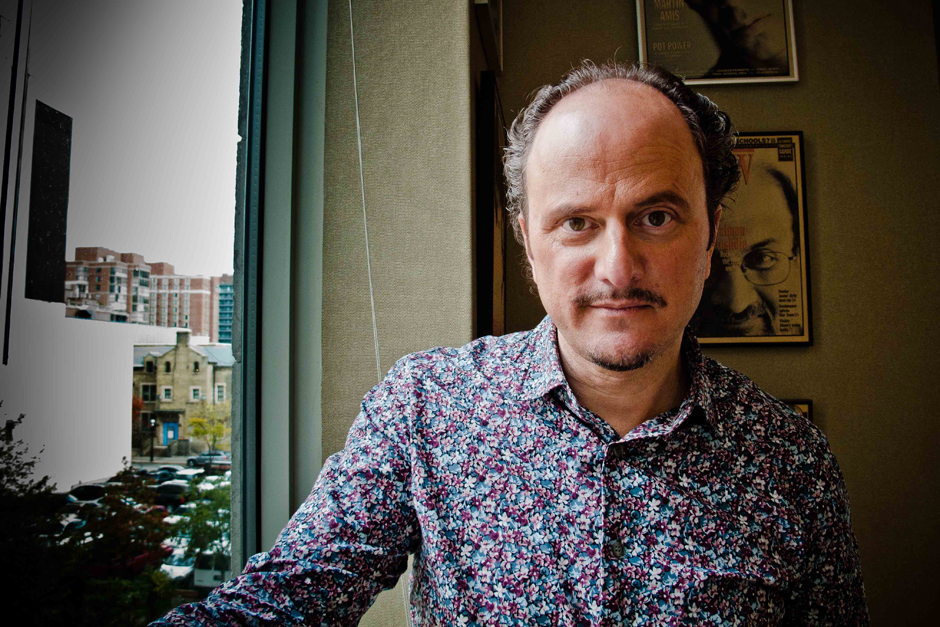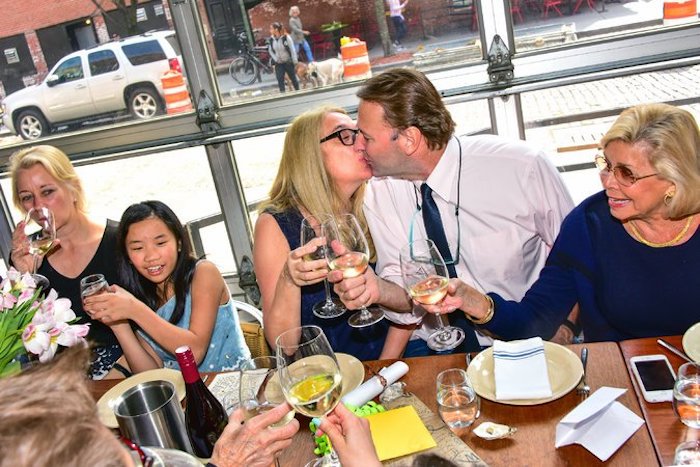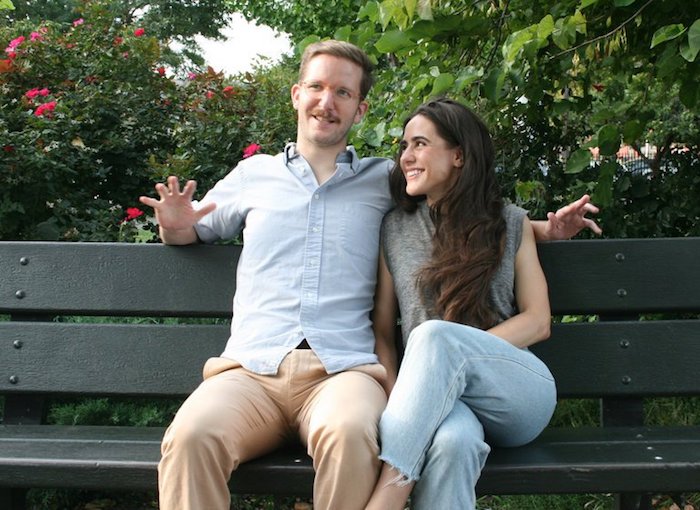
Literary Highlights from Everyone's Favorite Wedding Column
Or: Old Gossip is Still Good Gossip
Everyone loves some good literary gossip. To be fair, everyone loves good gossip of any kind. I shouldn’t have to explain this. I admit that I only recently discovered the trials and joys of the Vows column in the New York Times—here in the Lit Hub office, when I was definitely doing work—and let me tell you, it is serious rabbit-hole material. Call me Alice. I’d also take a small cake of some kind—especially after reading about all these fancy, treat-filled ceremonies. The meetings, courtships, and eventual weddings described in the Vows column range from the adorable to the absurd, but of course it was the literary ones that most captured my attention. So now, ladies and gentlemen, without any further ado, I present to you for the first time: ten highlights from literary couplings, as reported in The New York Times. Feel free to throw your rice now.

In the mid-90s, Jeffrey Eugenides, “a funny, intense novelist,” met his (now former) wife Karen Yamauchi, “a shy, soft-spoken sculptor,” at MacDowell. “A lot of my friends had gone to MacDowell, and they all got involved or had flings, and I was intent not to do that,” Eugenides told the Times. “I just didn’t want a stereotypical event to happen to me.” But alas, he met Yamauchi, and remembers thinking she “was beautiful, reclusive and surprisingly knowledgeable about trucks, tractors and other machinery.” A few weeks after they went back to New York, she moved in to his apartment, “arriving with all her belongings in paper bags. Although he cleared a drawer in his dresser for her, she didn’t use it for four months.” (She moves in and gets one drawer? I wouldn’t use it either, in protest.) According to the Times, “the two never became officially engaged. He said they became engaged when she finally agreed to use the drawer.” But a year and a half after meeting, they were married. Their wedding cake, designed by Gail Watson, was “a copy of one described in Madame Bovary,” which I can only imagine would be Emma’s wedding cake, as described by Gustave Flaubert:
At the base, to begin with, there was a square of blue cardboard representing a temple with porticoes, colonnades and stucco statuettes all around, in little niches decorated with gold paper stars; then on the second layer there was a castle made of Savoy cake, encircled by tiny fortifications of angelica, almonds, raising and segments of orange; and finally, on the upper platform, a green field with rocks and pools of jam and boats made out of nutshells, there was arrayed a little Cupid, perched on a chocolate swing, its two poles finished off with two real rose-buds, just like knobs, on the top.
More on that notoriously gaudy cake (Emma’s, not Jeff’s) here.
 Photo: Dolly Faibyshev for The New York Times
Photo: Dolly Faibyshev for The New York Times
Ah, a marriage that began with a shout—at Breadloaf, no less, in 1988. “I saw Ann [Hood], who had already established herself as a great writer, walking down a path, arm-in-arm, with two other novelists,” Michael Ruhlman told the Times. “At the time, I was an aspiring writer trying to ingratiate myself with as many novel and fiction writers as I could. . . . [So] I just sort of yelled “Ann Hood” in her direction. I don’t know why I did it, I just did.” Romantic! After a brief exchange, they parted—but 20 years later, they were both speaking at a conference in Cleveland. Hood noticed the “cute guy” but didn’t remember him. Then Ruhlman stood up and said, “I’m a little nervous today because Ann Hood is in the audience, and I’ve been in love with her since 1988.” They reconnected—and began a long-distance friendship, “chatting on occasion via email and text, each learning a little bit more about the other with every press of a send button.” Six years after Cleveland, in the fall of 2014, they reconnected yet again in New York, and this time, sparks flew—aided by food and poetry, Cupid’s best handmaidens. A year and a half later, they had both divorced their spouses (scandal), and on Hood’s birthday, December 6th, 2016, Ruhlman asked her to marry him. Laura Lippman officiated the ceremony, where Hood read Robert Frost’s “Master Speed” and Ruhlman read Emily Dickinson’s “Hope is the Thing With Feathers.”
 Photo: Devin Yalkin for The New York Times
Photo: Devin Yalkin for The New York Times
“Elizabeth Wurtzel Finds Someone to Love Her,” the Times cheers in 2015—which seems pretty petty until you recall, as her “Vows” piece does, that in her memoir Prozac Nation she declared that no one ever would. Wurtzel met James Freed Jr. at a literary event where they were both reading. “I thought he was cute and seemed like a good, solid guy,” Wurtzel said. They made plans to meet up for the Greenwich Village Halloween parade, and “the courtship took off quickly” after that. After they set the date for their wedding, Wurtzel was diagnosed with breast cancer, but even that and the ensuing chemotherapy didn’t shake them up much. “I’m Jewish, and we don’t postpone weddings,” Wurtzel told the Times.
 Photo: Phil Mansfield for The New York Times
Photo: Phil Mansfield for The New York Times
In 2007, Andrew Golis, current General Manager of Vox, but then at Talking Points Memo, emailed feminist author Jessica Valenti to see if she’d be interested in contributing to his site. One thing led to another, and they met up for dinner, a dinner in which Valenti apparently coaxed him into eating ceviche, even though he hated it. That’s how “brilliant and funny and beautiful” she was! Anyway, it made him so sick that he “bolted as soon as they reached the apartment where he was staying, fearing that he might vomit.” But they went out again, and eventually decided to get married. Valenti, of course, was swamped by criticism. How dare she, a feminist, get married? According to the Times, at least one blogger called it “the death of feminism.” But turns out, it wasn’t. The bride, by the way, wore light grey—and the couple danced to “All You Need is Love.”
 Photo: Matt Roth for The New York Times
Photo: Matt Roth for The New York Times
Once upon a time, an editor for Fast Company messaged a novelist on OKCupid. “He used a semicolon correctly; that was reason enough to get a drink with him,” Jennifer Miller told the Times. Good thing too, because Jason Feifer had been looking for “a Jewish writer,” and he was immediately smitten. Miller, not so much. “I felt comfortable being single,” she said, “but I thought, if this doesn’t work, I at least met a journalism contact.” But Feifer won her over:
On their first date, when he mentioned that he has no sense of smell, she asked if he liked foods because of their texture. “That would be like enjoying food for the size of the silverware,” he replied. When Ms. Miller told him that she was, in fact, an aficionado of miniature cutlery, Mr. Feifer arrived early for their next date to replace the restaurant’s silverware with a tiny fork and spoon, carefully rewrapping the napkin.
Their relationship was tested when Miller asked Feifer for feedback on the draft of her first novel. “Not only was it not my project,” he said, “but I knew I could get booted out of the larger project of our relationship.” But his edits only cemented their bond. “The benefit of having a journalist as an editor is he’s practical, not like being workshopped by M.F.A. students,” Miller told the Times. They were married in October of 2011.
 Photo: Tony Cenicola for The New York Times
Photo: Tony Cenicola for The New York Times
In February of 2000, Susan Orlean’s 16-year marriage was ending. She was “wondering if perhaps she was destined to be alone” when a friend, humor writer Patty Marx, set her up with John William Gillespie Jr., whose own 16-year marriage was over too. She trusted Marx, but also ”knew he was an investment banker, which sort of scared me,” she told the Times. ”It sounded dull.” But as it turns out, he wasn’t full at all. ”He was incredibly smart, fantastically funny and really had the soul of a poet encased in the trappings of a very smart and successful businessman,” she said. Three days later, they were both in love, and said so. According to the Times, they also had sex: “For their third [date], they planned to relax and read books at an inn in the Berkshires, but he got only to the second paragraph of his, and she to the second page of hers.” Ooh la la! Their courtship only got better (and more ludicrous, honestly) from there:
For their fourth date, they jetted off to Thailand for massages. Soon, they ventured to London. Eventually they headed to Istanbul, where on New Year’s Eve, on the terrace of a hotel overlooking the Blue Mosque, Mr. Gillespie proposed as fireworks exploded overhead. And on Valentine’s Day, he surprised her with tickets to ”The Lion King” and a visit in Ms. Orlean’s Manhattan apartment from a 250-pound, 5-month-old lion cub that Mr. Gillespie had arranged with an animal control officer he had met on a plane earlier that week.
They were married only nine months after their first meeting, at a wedding one guest apparently likened to “Dorothy Parker’s round table, only better dressed.”
 Photo: Daniel Barry for The New York Times
Photo: Daniel Barry for The New York Times
Amy Sohn fixed up her friend, novelist Jennifer Belle (5-foot-1) with her attorney, because she knew she loved Woody Allen movies, and he—Andrew Krents—was “very Woody Allenish. He’s incredibly strange, funny, bright and gregarious. He’s not afraid of his own wacky side,” she told the Times. Plus, he was 5-foot-4. Belle herself would edit that statement. “He’s a combination of Woody Allen, Dustin Hoffman and Bob Dylan,” she said. They went on a date at the Bowery Bar, and later to a “Truth or Dare” party, since apparently those exist, and Belle, being dared, wound up kissing a playwright’s neck. The Times reports:
Mr. Krents, who friends say has always acted 20 years older than his age, became slightly unglued. “Here we were just getting to know each other,” he said, ”and you don’t know if you’re even going to get to a second date, and here are people doing unspeakable things that you do on the fourth or fifth dates.”
But a year later they moved in together, and they were married in 2002. Their first dance was to Randy Newman’s “Short People.”
 Photo: Cheryl Senter for The New York Times
Photo: Cheryl Senter for The New York Times
Joyce Maynard, who as you may recall, dropped out of college at 19 to move in with J.D. Salinger, and then later wrote a memoir about their affair, met Jim Barringer on Match.com in 2011. “I’m a believer in diving in,” she told the Times. “It has sometimes been disastrous and painful for me but I think I have better judgment about where to dive now. I’d like to have tattooed on my wrist: What’s the worst that can happen?” The two are a bit of an odd couple—she is messy and wild, he is serious, his house “austere.” “She’s full of fun,” Barringer said. “I may seem a little reserved and stuffy but I really value somebody who’s willing to do things with spontaneity and not according to some rule book, and that’s Joyce.” As for the actual vows:
The couple each said their own vows, a combination of compliments and promises. Wearing a tuxedo, a red bow tie and old-school eyeglasses, Mr. Barringer said, “I love how you think, full of reason, like greased lightning, like a quantum computer.” And: “I promise to work at bridging the gaps between us. The gaps will come up, like cracks in the ground, because we are very different people.”
Before reading her vows, which were considerably longer than his, Ms. Maynard told the guests: “Put your feet up. Stretch a little. I do have a lot to say.”
She said she loved the fact that Mr. Barringer woke up early, never complained, never closed his heart to sorrow and once tried to ward off a would-be robber in the middle of the night with a hiking pole, while stark naked.
She also said, “I love it that in your eyes, I am the babe of the universe, although that calls your eyesight into question.”
And: “So long as I can walk, I will dance with you. I will bake you apple pies and never wear flannel nightgowns.”
One more thing: according to the Times, “the 150 guests seemed like the sort of people who know poems by heart, dance and sing without inhibition and give more hugs than handshakes.” Maynard wrote a biography for each guest, and had it printed and bound as a wedding favor. I bet that earned her quite a number of hugs.
 Photo: Jay Dockendorf & Nozlee Samadzadeh
Photo: Jay Dockendorf & Nozlee Samadzadeh
This recent installation does not involve any famous writers, but since it’s entitled “Stranger Than Fiction: What Happened After the Bookstore,” and also includes the terms “Williamsburg,” “W. W. Norton and Company,” “McNally Jackson Books,” “St. Mark’s Bookshop,” “East Village,” “Anne Carson,” “Granta,” and “Ed Park,” I think it counts. Molly Higgins Fischer, features editor at New York magazine’s The Cut, and Samuel Chandler MacLaughlin, manager of the Williamsburg branch of McNally Jackson. They met, of course, in a bookstore:
Ms. Fischer and Mr. MacLaughlin caught each other’s eye browsing the fiction stacks, but said nothing. They moved slowly around each other for almost an hour without saying a word.
“I saw this very cute girl and was browsing around her, and thought, she seems to be browsing around me,” Mr. MacLaughlin said. “We both spent way too long doing that. Eventually I thought, this is ridiculous, I know I’m not going to say anything, I’ll just go. I’ll buy a book of Anne Carson poetry and hopefully impress her on the way out.”
After an embarrassment of eye-contact (and I mean “embarrassment” in the sense of “a lot” and of “the feeling I get reading about it”), MacLaughlin went home to tweet about the experience, and the novelist Ed Park encouraged him to post a Missed Connections about her, because apparently people still do that. Here it is:
Girl with a Granta bag, m4w (East Village)
Yesterday at almost ten we were in the bookstore, each carrying a bag from a literary magazine. Then we rode the L train together. We made a lot of eye contact, which was nice. Craigslist remains weird; who are you?
It worked.
 Photo: Charlie Rose
Photo: Charlie Rose
Bonus: Did you know that Janet Maslin, long-time film critic and current New York Times book reviewer, is married to John Cheever‘s son? I did not. Not only that, but according to this 1981 wedding announcement, “Mr. Cheever is a grandson of the late Dr. Milton Winternitz, who was dean of the Yale Medical School, and a great-grandson of Thomas Augustus Watson of Boston. Mr. Watson was an assistant to Alexander Graham Bell, whose first words on his famous instrument were, “Mr. Watson, come here. I want to see you.””
Emily Temple
Emily Temple is the managing editor at Lit Hub. Her first novel, The Lightness, was published by William Morrow/HarperCollins in June 2020. You can buy it here.



















